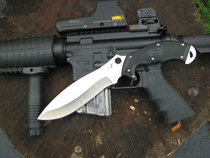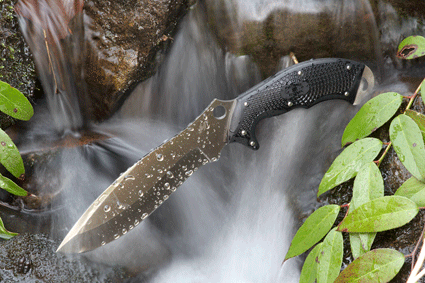In the March 2008 issue of Tactical Knives, the editor, Steven Dick, previewed the first fixed-blade design to come out of the collaboration between Spyderco and custom knife maker Ed Schempp, the Spyderco Rocksalt. I’ve now had the opportunity to really take the Rocksalt out into the field and see just what it is made of.
 The Rocksalt was designed as an outdoors blade geared towards general camp chores and jungle survival. It is a midsized knife with an overall length of 10-1/2 inches, which includes the sharply raked handle that is fi tted with bi-directional textured FRN scales. The 6-3/4-inch recurved blade is 1/8-inch thick and has a strong Kukri influence to it. There are two lanyard holes on the knife, one in the common position at the butt of the knife, and another just forward of the grip at the location you’d expect to see a Spyderhole on a Spyderco folder. This forward hole is designed to accept a shorter lanyard to secure the knife while chopping. At 9.2 ounces, the Rocksalt is surprisingly light for its size. The high hollow grind and spine swedge help to keep weight down and the Rocksalt is skeletonized under the handle scales for further weight reduction and balance.
The Rocksalt was designed as an outdoors blade geared towards general camp chores and jungle survival. It is a midsized knife with an overall length of 10-1/2 inches, which includes the sharply raked handle that is fi tted with bi-directional textured FRN scales. The 6-3/4-inch recurved blade is 1/8-inch thick and has a strong Kukri influence to it. There are two lanyard holes on the knife, one in the common position at the butt of the knife, and another just forward of the grip at the location you’d expect to see a Spyderhole on a Spyderco folder. This forward hole is designed to accept a shorter lanyard to secure the knife while chopping. At 9.2 ounces, the Rocksalt is surprisingly light for its size. The high hollow grind and spine swedge help to keep weight down and the Rocksalt is skeletonized under the handle scales for further weight reduction and balance.
The steel used in the Rocksalt is Spyderco’s H1. H1 is infused with nitrogen rather than carbon and, unlike more common stainless steels, it’s actually non-rusting. H1 also isn’t heat-treated. No, that doesn’t mean it’s going to lose its edge fast or not take one in the first place. It’s precipitation-hardened steel, which means that it’s naturally hard and doesn’t need a heat-treat process to make it that way. It also is said to actually get harder with use. Now, I’m no metallurgist and both the non-rusting and naturally hardened attributes of H1 make it seem a little like magic to me. I’ll have to take the word of Spyderco’s engineers on this one until I see how this works for myself. Trust, but verify.
Advertisement — Continue Reading Below
The Spyderco Rocksalt comes with a black injection-molded FRN sheath, complete with multi-position G-clip. Retention on the sheath is good, yet it still allows fast and easy access to the blade. The sheath adds a few ounces of weight to the package, but both combined still come in at a feathery 13 ounces.
Rocksalt Afield
I had the opportunity to use the Rocksalt during a couple of trips this year and got a good feel for how it handles. The first thing you notice when you pick one up is that the Rocksalt is a lot lighter than it first appears. When I had seen pictures of the design, I was expecting a heavy bladed chopper. What I actually got was a light, nimble slashing blade. While the Rocksalt doesn’t have the mass to brutally hack through objects, it does work well at snap cuts and does a nice job on vines, light brush and shrubs. I also found it worked just fine on poplar saplings in the 1.5- to 2-inch range. This size is perfect for hiking staves, shelter poles, travois litter poles and other tasks. The snap cut worked just fine for limbing saplings as well. Batoning the limbed poles over a stump was an effective way to trim them down to size and the Rocksalt handled that with ease. Its thin blade would typically make nice clean cuts through the poles in one or two blows at most.
The thin edge worked well on both wood and food. I found that it was comfortable to use for stripping bark and whittling by choking up and using the finger choil. Control with this hold was quite good and the Spyderco’s factory edge bit well into poplar, tulip and even an Osage orange walking stick that I was carving. The thin blade worked great as a camp kitchen blade, too, and shaved nice, thin slices off a huge cheese wheel that we had on one of the trips. It also made short work of summer sausage and pepperoni sticks as well. You could very easily leave your dedicated kitchen blades at home if you have a Rocksalt on an outdoors excursion. Not only does it work well for these chores, but its H1 blade is also a breeze to clean up. You’re unlikely to have to worry about any sort of food staining its blade either.
Advertisement — Continue Reading Below
Rust And Edge Test
I tried out the Rocksalt’s rust resistance and edge-holding ability during testing, too. Normally, when I’m using a knife, I’ll periodically clean it up and wipe it down with oil, especially if it gets wet while in use. With the Rocksalt, not only did I not do this, but I deliberately left it out in the rain, abandoned overnight in wet leaves, and stuck it into a rotten stump between tasks. I’d just stuff it back into the sheath when I was ready to use it and keep going. I have yet to see any signs of rust or discoloration on the blade. Like I said before, it’s magic! I’ve managed to rust stainless steel a number of times in the past, so while I appreciate the rust resistance, I never have taken for granted that it couldn’t still rust. With Spyderco’s H1 it looks like you really don’t have to worry about it. Edge retention has been excellent as well. Despite chopping, batoning and lots of whittling of hard woods, the edge seems pretty darn close to how I received it from the factory. I’m probably going to have to keep working with this one a while longer before I have to find out how it is to sharpen H1. At this point it doesn’t need anything other than perhaps a quick stropping to touch up the edge.
H1 Workhorse Steel
Spyderco’s H1 steel makes the Rocksalt suitable for a number of environments that would normally chew up other knives. A rustproof blade would be a great comfort in many parts of Africa or the South American jungle. It would also be a huge boon around any saltwater bodies, either as part of a nautical survival kit or for use while fishing or camping along the shoreline. Kayakers and other recreational boaters, too, would benefit from a blade they could carry or store on their boats without worrying much about maintenance. Whether you’re in the Pacific Northwest or on the Pacific Rim, the Rocksalt should be able to handle whatever sort of conditions you have, be they simply damp backpacking trips or a post tsunami recovery operation.
Pulling Defense Duty
While perhaps not designed as a fighting blade, I had a number of people comment that the Rocksalt would make a mean defensive tool. It’s light and nimble in the hand and makes wickedly fast slashes with its long recurved blade. The grip angle makes thrusts as easy as punching and the swedged tip should offer excellent penetration. Its light weight and essentially maintenance-free H1 and FRN construction would be welcome features for military troops or folks carrying a blade close to the skin, especially in hot, humid conditions. While I certainly don’t make any claims to knife-fighting prowess, it doesn’t take an expert to see the possibilities inherent in the Rocksalt’s design.
Advertisement — Continue Reading Below
A Better Bush Blade
While the design may be a bit unconventional for those accustomed to traditional bushcraft blades, I think the Rocksalt may be in a position to challenge the norms when it comes to a do-it-all knife for camp and trail. Its light weight makes it easy to carry despite its largish, 6-inch-plus cutting edge and it certainly doesn’t lack in performance on wood, food preparation or firewood prep. Add in the rustproof attributes and you’ve got a blade that’s ready to take on most anything a user cares to throw at it, no matter how wet the conditions might get!























